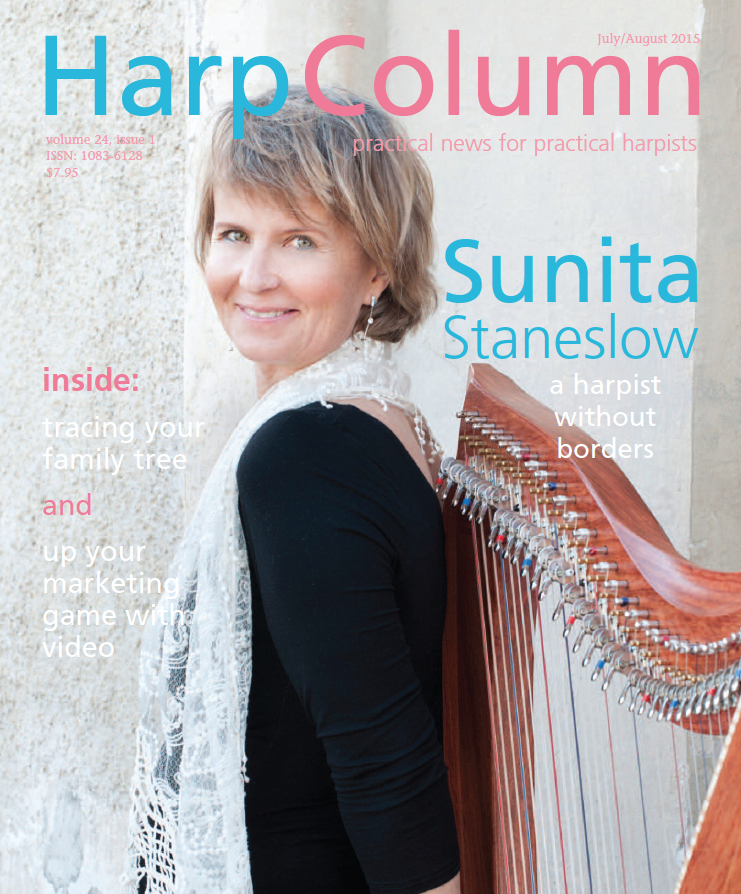
Harp Column CD reviewer Alison Young raved about Tristan le Govic’s new CD Elva in the March/April 2015 issue. If that inspired you to buy the CD, listening to it may inspire you to buy his self-published book of the same title (available at www.tristanlegovic.eu). It includes all but the one tune sung a capella on the CD. Four of the pieces are from Scandinavian repertoire, four are from Celtic repertoire, and two are le Govic’s original compositions.
Only the vocal line and lyrics are included for “N’em eus ket nameit ur blank,” the selection that featured two voices on the recording (le Govic himself and Swedish singer Lise Enochsson). The rest of the pieces are written for solo Celtic harp tuned to E-flat. You will need a full set of levers and 36–38 strings, going down to sixth octave C or below. No fingering is suggested.
Much of the music could be played on pedal harp but works far better on lever harp as several pieces would require enharmonic substitutions. No pedal markings are included. Lever changes are notated by extremely tiny notes in a box on the staves at the point of execution. Although they are difficult to see, the meaning is clear, and the box alerts you to the change.
Mr. Le Govic uses special effects such as damping, three-fingered as well as nail glissandi, whistling sounds (rubbing the bass strings), harmonics, grace notes, and lever slides to add color and interest.
Even though they are a traditional Norwegian dance and Breton march, respectively, “Jag tänker så titt,” and “Ton bale Elva”, have such a jazzy feel you might think you are channeling Deborah Henson-Conant. “Calum Sgaire,” a Scottish air, and “Kibò no kodomotachi,” an original composition mourning the tragic Fukushima nuclear power plant disaster, are probably the easiest to play. “Gavotenn Pourlet” is a very lively Breton dance and requires solid technique and accurate fingering.
An original composition, “Hosing the Flowers” is the longest at nine pages. It requires a fairly elaborate pre-setting of levers (and would be a pedaling nightmare). Described as “a tune between an old cakewalk and a ragtime in C-sharp,” the composer instructs you to tune the top three strings slightly out of tune to imitate a honky-tonk piano. There is a cadenza that uses the sixth octave B and A, but this could be modified for harps without those lower notes.
The large left hand expanses throughout and some fast tempi make this collection suitable for the advanced lever harp player. The typesetting is easy to read but some page turns are difficult. Performance notes in both English and French provide some useful instructions. Lyrics and descriptions of the pieces are at the back of the book.
There are a few adaptations from the harp part heard on the recording in order to perform them as solos. The result is a collection of very engaging repertoire illustrating the artistry of Tristan le Govic.

Another wonderful new collection that can be played on lever or pedal harp is Nine Sephardic Songs arranged for voice and harp by Samuel Milligan. He describes this pairing as “the most beautiful combination possible” and chose the Spanish diatonic harp as the ideal accompaniment. No pedal markings are included, but there are instructions at the beginning of a piece if you have to prepare any levers in advance.
The spiral-bound volume is published by WingsPress and does not include a separate part for voice. The introduction contains an informative synopsis of the history of Sephardic music. Mr. Milligan provides an English translation of the lyrics at the end of each piece.
“Cuando el Rey Nimrod al Compo Salia” appears twice: once for harp, voice, tambourine, and tenor drum, and again with just the percussion and voice parts. The voice and harp alternate handling the melody on “Aquel Rey de Francia.” “Durme, Durme, Hermozo Hijico” is a beautiful cradle song with a couple of tricky page turns. The harp establishes the melody on “Puncha, Puncha, la Rosa Huele” before the voice enters. “Adio, Querido” is a hauntingly beautiful piece with the harp playing arpeggios for accompaniment. “Ah, el Novio No Quere Dinero” is a peppy tune with the harp playing mostly chords except for the introduction and two-measure interludes between verses. “Arboles Lloran por Luvia” has frequent meter changes. “La Rosa Enflorece” has a couple of ascending scales played with the second finger to muffle the previous note. The final piece, “Como la Rosa en la Guerta” is a sad lament of a mother for her dead daughter.
Intermediate to advanced players should be able to sightread most of this music. Fingering is only occasionally suggested, but most of the notes fall comfortably in the hands.
Mr. Milligan is a deft arranger and uses lovely open chord voicings that allow the harp to ring. This assortment can also be played with a melody instrument, such as violin or flute, so don’t wait for an opportunity to play with a singer to use these beautiful songs. •







